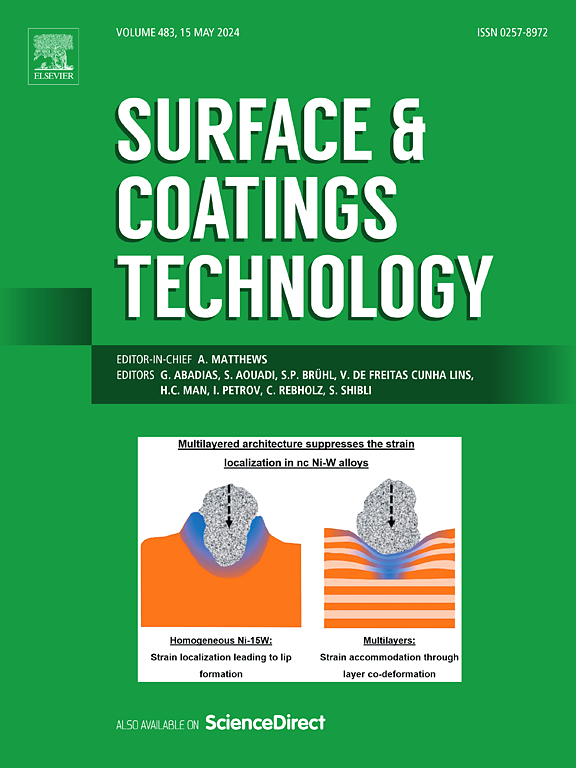Microstructure and oxidation behavior of a laser-deposition WTaNbMo/γ-(Ni, Cr) refractory high-entropy alloy coating with dynamic magnetic field assistance
IF 5.3
2区 材料科学
Q1 MATERIALS SCIENCE, COATINGS & FILMS
引用次数: 0
Abstract
In this study, WTaNbMo/γ-(Ni, Cr) refractory high-entropy alloy composite coatings were successfully fabricated through magnetic field-assisted laser deposition. A comprehensive investigation was conducted to elucidate the effects of magnetic field on the microstructural evolution of the coatings. Magnetic field assistance effectively eliminated surface cracks, enhanced compositional homogeneity, and reduced texture (by 57.39 %) and grain size (by 79.19 %) in the laser-deposition composite coating. Furthermore, the influence of γ-(Ni, Cr) content on the high-temperature oxidation resistance was systematically examined from both thermodynamic and kinetic perspectives. The results demonstrated that increasing γ-(Ni, Cr) content progressively reduced oxide film thickness and improved high-temperature oxidation resistance. However, excessive γ-(Ni, Cr) content was found to substantially compromise the high-temperature hardness. The optimal balance of high-temperature properties and oxidation resistance was achieved at 62.26 % γ-(Ni, Cr) content, exhibiting a high-temperature hardness of 237.5 HV0.5 and a 1000 °C 24-h oxidation weight gain of 6.923 mg/cm2. The enhanced high-temperature oxidation resistance of the WTaNbMo/γ-(Ni, Cr) composite coatings is attributed to the formation of a dense protective oxide film Cr₂O₃/CrNbO₄/CrTaO₄. This multi-component oxide film effectively shields the composite from further oxidation, thereby significantly reducing the oxidation rate and improving the high-temperature performance.
动态磁场辅助下激光沉积WTaNbMo/γ-(Ni, Cr)难熔高熵合金涂层的组织与氧化行为
采用磁场辅助激光沉积法制备了WTaNbMo/γ-(Ni, Cr)难熔高熵合金复合涂层。研究了磁场对涂层微观组织演变的影响。磁场辅助能有效消除表面裂纹,增强成分均匀性,减小织构(减少57.39%)和晶粒尺寸(减少79.19%)。此外,从热力学和动力学的角度系统地考察了γ-(Ni, Cr)含量对高温抗氧化性能的影响。结果表明,随着γ-(Ni, Cr)含量的增加,氧化膜厚度逐渐减小,耐高温氧化性提高。然而,过量的γ-(Ni, Cr)含量大大降低了高温硬度。当γ-(Ni, Cr)含量为62.26%时,合金的高温硬度为237.5 HV0.5, 1000℃24 h氧化增重为6.923 mg/cm2,达到了高温性能和抗氧化性能的最佳平衡。WTaNbMo/γ-(Ni, Cr)复合涂层的高温抗氧化性增强是由于形成了致密的保护氧化膜Cr₂O₃/CrNbO₄/CrTaO₄。这种多组分氧化膜有效地屏蔽了复合材料的进一步氧化,从而显著降低了氧化速率,提高了高温性能。
本文章由计算机程序翻译,如有差异,请以英文原文为准。
求助全文
约1分钟内获得全文
求助全文
来源期刊

Surface & Coatings Technology
工程技术-材料科学:膜
CiteScore
10.00
自引率
11.10%
发文量
921
审稿时长
19 days
期刊介绍:
Surface and Coatings Technology is an international archival journal publishing scientific papers on significant developments in surface and interface engineering to modify and improve the surface properties of materials for protection in demanding contact conditions or aggressive environments, or for enhanced functional performance. Contributions range from original scientific articles concerned with fundamental and applied aspects of research or direct applications of metallic, inorganic, organic and composite coatings, to invited reviews of current technology in specific areas. Papers submitted to this journal are expected to be in line with the following aspects in processes, and properties/performance:
A. Processes: Physical and chemical vapour deposition techniques, thermal and plasma spraying, surface modification by directed energy techniques such as ion, electron and laser beams, thermo-chemical treatment, wet chemical and electrochemical processes such as plating, sol-gel coating, anodization, plasma electrolytic oxidation, etc., but excluding painting.
B. Properties/performance: friction performance, wear resistance (e.g., abrasion, erosion, fretting, etc), corrosion and oxidation resistance, thermal protection, diffusion resistance, hydrophilicity/hydrophobicity, and properties relevant to smart materials behaviour and enhanced multifunctional performance for environmental, energy and medical applications, but excluding device aspects.
 求助内容:
求助内容: 应助结果提醒方式:
应助结果提醒方式:


